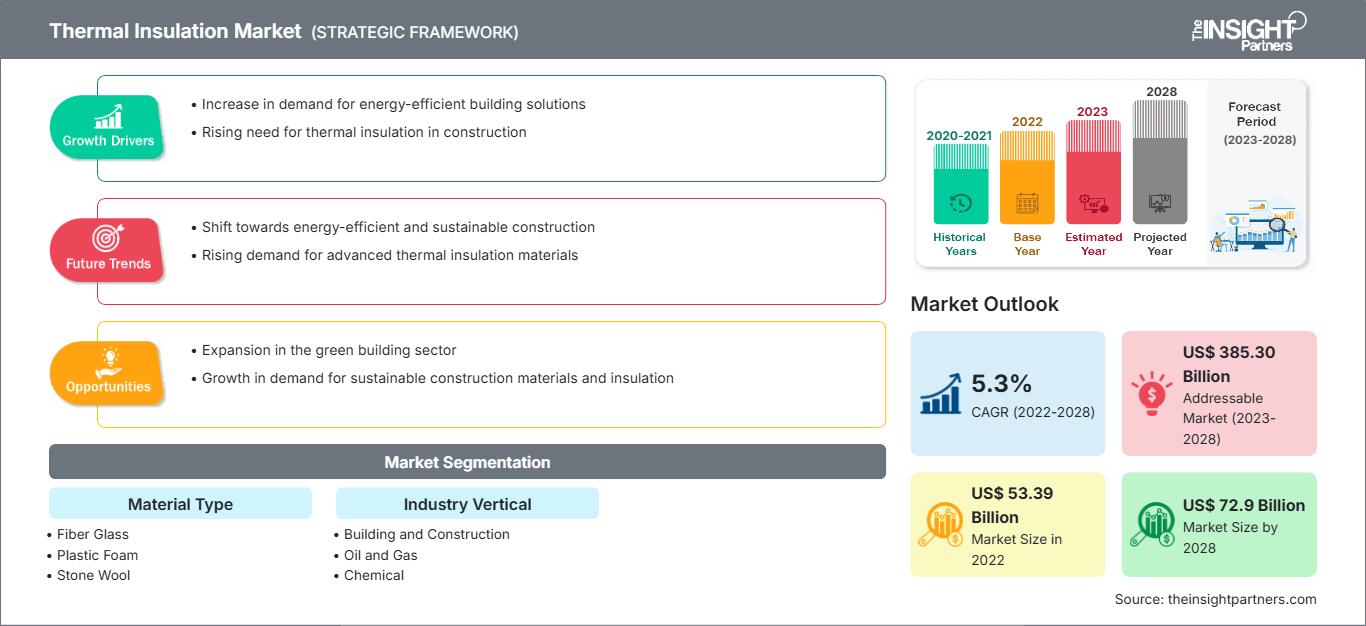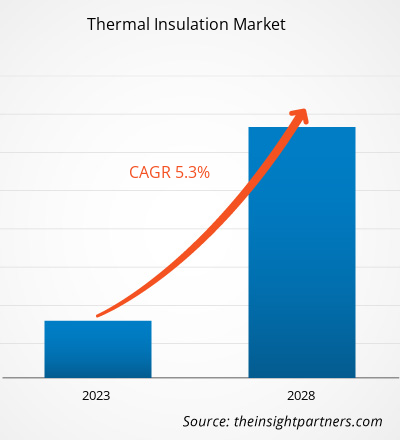Der Markt für Wärmedämmung soll von 53,39 Milliarden US-Dollar im Jahr 2022 auf 72,90 Milliarden US-Dollar im Jahr 2028 wachsen; von 2022 bis 2028 wird mit einer durchschnittlichen jährlichen Wachstumsrate von 5,3 % gerechnet.
Die Nachfrage nach Wärmedämmung ist aufgrund ihrer Vorteile gestiegen. Sie reduziert die Energiekosten und den Wärmeübergang zwischen zwei Objekten mit unterschiedlichen Temperaturen. Wärmedämmmaterial bietet eine Isolierung, bei der die Strahlungswärme reflektiert, reduziert und absorbiert wird. Unternehmen konzentrieren sich auf leichte Produkte wie Kunststoff, da diese einfach zu installieren sind und weniger Zeit und Aufwand erfordern. Diese Faktoren dürften das Wachstum des Marktes für Wärmedämmung verstärken.
Der Markt für Wärmedämmung wird in den kommenden Jahren voraussichtlich ein erhebliches Wachstum verzeichnen, dank der starken Präsenz namhafter Akteure wie BASF SE, Bayer AG, ROCKWOOL A/S, Johns Manville, SAINT GOBAIN SA, Kingspan Group PLC, Dow Chemicals Company, Owens Corning, Asahi Kasei Corporation und DuPont. Eine große Vielfalt an Wärmedämmprodukten hat die Aufmerksamkeit der Verbraucher auf sich gezogen. Das wachsende Bewusstsein für die Vorteile von Hochtemperaturdämmung, einschließlich der Beständigkeit gegen erhöhte Temperaturen und Temperaturschocks, der geringen Wärmeleitfähigkeit, der Umweltfreundlichkeit und der Kosteneffizienz, wird das Wachstum des Marktes für Wärmedämmung im Prognosezeitraum voraussichtlich vorantreiben.
Im Jahr 2021 hatte der asiatisch-pazifische Raum den größten Anteil am globalen Markt für Wärmedämmung. Nordamerika wird im Prognosezeitraum jedoch voraussichtlich die höchste durchschnittliche jährliche Wachstumsrate (CAGR) des Marktes verzeichnen. Der APAC-Markt ist in China, Indien, Australien, Japan, Südkorea und den Rest der APAC-Region unterteilt. Die Bauindustrie ist aufgrund der schnell wachsenden Bevölkerung eine der boomenden Branchen in der Region Asien-Pazifik. Dies führt letztlich zu einer hohen Nachfrage nach Wärmedämmprodukten. Darüber hinaus sind das steigende verfügbare Einkommen der Verbraucher und das Wachstum der Mittelschicht einige der Hauptfaktoren, die das Wachstum des Wärmedämmstoffmarktes in der Region vorantreiben.
Passen Sie diesen Bericht Ihren Anforderungen an
Sie erhalten kostenlos Anpassungen an jedem Bericht, einschließlich Teilen dieses Berichts oder einer Analyse auf Länderebene, eines Excel-Datenpakets sowie tolle Angebote und Rabatte für Start-ups und Universitäten.
Markt für Wärmedämmung: Strategische Einblicke

- Holen Sie sich die wichtigsten Markttrends aus diesem Bericht.Dieses KOSTENLOSE Beispiel umfasst Datenanalysen, die von Markttrends bis hin zu Schätzungen und Prognosen reichen.
Sie erhalten kostenlos Anpassungen an jedem Bericht, einschließlich Teilen dieses Berichts oder einer Analyse auf Länderebene, eines Excel-Datenpakets sowie tolle Angebote und Rabatte für Start-ups und Universitäten.
Markt für Wärmedämmung: Strategische Einblicke

- Holen Sie sich die wichtigsten Markttrends aus diesem Bericht.Dieses KOSTENLOSE Beispiel umfasst Datenanalysen, die von Markttrends bis hin zu Schätzungen und Prognosen reichen.
Auswirkungen der COVID-19-Pandemie auf den Markt für Wärmedämmung
Vor der COVID-19-Pandemie wurde das Wachstum des Marktes für Wärmedämmung hauptsächlich durch die steigende Nachfrage nach Gebäuden und Bautätigkeiten vorangetrieben. Im ersten Quartal 2020 sah sich der Markt jedoch mit Hürden aufgrund von Geschäftsschließungen, Rohstoff- und Arbeitskräftemangel sowie einem Rückgang der Bau- und Transportaktivitäten konfrontiert. Die COVID-19-Pandemie führte in den ersten Monaten des Jahres 2020 zu einer Wirtschaftsrezession, die Verbraucher mit niedrigem und mittlerem Einkommen in finanzielle Schwierigkeiten brachte.
Darüber hinaus beeinträchtigten die Schließung vieler Bauunternehmen und der Produktion aufgrund von Einschränkungen das Wachstum des Marktes für Wärmedämmung. Während der Pandemie war der Arbeitskräftemangel außerdem ein großes Problem für die Wärmedämmungsbranche. Dies führte in der Wärmedämmstoffbranche zu einem Trend hin zu Mechanisierung, Automatisierung und Offsite-Fertigung.
Markteinblicke
Vorteile der Wärmedämmung
Wärmedämmung reduziert Wärmebewegungen und Dampfkondensation. Dadurch beugt sie Feuchtigkeit, Schimmel, Frost und Verformungen im Gebäude sowie der Schwächung von Eisenteilen durch Korrosion vor und trägt zur Gebäudeerhaltung bei. Darüber hinaus können in verschiedenen Branchen durch die Verwendung von Produkten wie BTU-BLOCK-Dämmung durch eine verringerte Wärmeleitfähigkeit in der Verkleidungskonstruktion enorme Energieeinsparungen erzielt werden.
Basierend auf dem Materialtyp wird der globale Markt in Glasfaser, Schaumstoff, Steinwolle, Calciumsilikat, Schaumglas und andere unterteilt. Im Jahr 2021 hatte das Glasfasersegment den größten Umsatzanteil, und für Schaumstoff wird im Prognosezeitraum die höchste Wachstumsrate erwartet. Nach Branchen ist der globale Markt in die Bereiche Bauwesen, Öl und Gas, Chemie, Luft- und Raumfahrt und Verteidigung, Automobilindustrie, Pharmazie und andere unterteilt. Der Bausektor erwirtschaftete den größten Umsatzanteil.
BASF SE, Bayer AG, ROCKWOOL A/S, Johns Manville, SAINT GOBAIN SA, Kingspan Group PLC, Dow Chemicals Company, Owens Corning, Asahi Kasei Corporation und DuPont sind einige der wichtigsten Akteure auf dem Markt für Wärmedämmung. Diese Unternehmen bieten ein breites Produktportfolio für den Markt. Sie sind in Entwicklungsregionen präsent und bieten so lukrative Marktchancen. Marktakteure entwickeln qualitativ hochwertige, innovative Produkte, um die Kundenanforderungen zu erfüllen.
Berichts-Spotlights
- Fortschreitende Branchentrends auf dem Markt helfen den Akteuren bei der Entwicklung effektiver langfristiger Strategien
- Geschäftswachstumsstrategien in entwickelten und sich entwickelnden Märkten
- Quantitative Analyse der Marktgröße für Wärmedämmprodukte von 2022 bis 2028
- Schätzung der weltweiten Nachfrage nach Wärmedämmung
- PEST-Analyse zur Veranschaulichung der Effektivität von Käufern und Lieferanten in der Branche
- Jüngste Entwicklungen zum Verständnis des Wettbewerbsmarktszenarios
- Markttrends und -aussichten sowie Faktoren, die das Wachstum des Wärmedämmungsmarktes vorantreiben und hemmen
- Unterstützung im Entscheidungsprozess durch Hervorhebung von Marktstrategien, die das kommerzielle Interesse untermauern und zum Marktwachstum führen
- Die Größe des Wärmedämmungsmarktes an verschiedenen Knotenpunkten
- Detaillierte Übersicht und Segmentierung des Marktes sowie die Dynamik der Wärmedämmungsbranche
- Wärmedämmung Marktgröße in verschiedenen Regionen mit vielversprechenden Wachstumschancen
WärmedämmungRegionale Einblicke in den Markt für Wärmedämmung
Die Analysten von The Insight Partners haben die regionalen Trends und Faktoren, die den Markt für Wärmedämmung im Prognosezeitraum beeinflussen, ausführlich erläutert. In diesem Abschnitt werden auch die Marktsegmente und die geografische Lage in Nordamerika, Europa, dem asiatisch-pazifischen Raum, dem Nahen Osten und Afrika sowie Süd- und Mittelamerika erörtert.
Umfang des Marktberichts zur Wärmedämmung
| Berichtsattribut | Einzelheiten |
|---|---|
| Marktgröße in 2022 | US$ 53.39 Billion |
| Marktgröße nach 2028 | US$ 72.9 Billion |
| Globale CAGR (2022 - 2028) | 5.3% |
| Historische Daten | 2020-2021 |
| Prognosezeitraum | 2023-2028 |
| Abgedeckte Segmente |
By Materialtyp
|
| Abgedeckte Regionen und Länder | Nordamerika
|
| Marktführer und wichtige Unternehmensprofile |
|
Marktdichte der Akteure im Bereich Wärmedämmung: Auswirkungen auf die Geschäftsdynamik verstehen
Der Markt für Wärmedämmung wächst rasant. Die steigende Nachfrage der Endverbraucher ist auf Faktoren wie veränderte Verbraucherpräferenzen, technologische Fortschritte und ein stärkeres Bewusstsein für die Produktvorteile zurückzuführen. Mit der steigenden Nachfrage erweitern Unternehmen ihr Angebot, entwickeln Innovationen, um den Bedürfnissen der Verbraucher gerecht zu werden, und nutzen neue Trends, was das Marktwachstum weiter ankurbelt.

- Holen Sie sich die Markt für Wärmedämmung Übersicht der wichtigsten Akteure
Die „Marktanalyse für Wärmedämmung bis 2028“ ist eine spezialisierte und gründliche Studie der Konsumgüterindustrie mit besonderem Augenmerk auf der globalen Trendanalyse des Wärmedämmungsmarktes. Der Bericht soll einen Marktüberblick mit detaillierter Marktsegmentierung bieten.
Der Markt für Wärmedämmung ist nach Materialtyp, Industriezweig und Geografie segmentiert. Basierend auf dem Materialtyp ist der globale Markt in Glasfaser, Kunststoffschaum, Steinwolle, Kalziumsilikat, Schaumglas und andere segmentiert. Basierend auf dem Industriezweig ist der globale Markt in Bauwesen, Öl und Gas, Chemie, Luft- und Raumfahrt und Verteidigung, Automobil, Pharmazie und andere segmentiert. Geografisch ist der Markt grob in Nordamerika, Europa, Asien-Pazifik (APAC), Naher Osten und Afrika (MEA) sowie Süd- und Südamerika unterteilt. Mittelamerika.
Unternehmensprofile
BASF SE, Bayer AG, ROCKWOOL A/S, Johns Manville, SAINT GOBAIN SA, Kingspan Group PLC, Dow Chemicals Company, Owens Corning, Asahi Kasei Corporation und DuPont sind die führenden Akteure auf dem globalen Markt für Wärmedämmung.
- Historische Analyse (2 Jahre), Basisjahr, Prognose (7 Jahre) mit CAGR
- PEST- und SWOT-Analyse
- Marktgröße Wert/Volumen – Global, Regional, Land
- Branchen- und Wettbewerbslandschaft
- Excel-Datensatz
Aktuelle Berichte
Verwandte Berichte
Erfahrungsberichte
Grund zum Kauf
- Fundierte Entscheidungsfindung
- Marktdynamik verstehen
- Wettbewerbsanalyse
- Kundeneinblicke
- Marktprognosen
- Risikominimierung
- Strategische Planung
- Investitionsbegründung
- Identifizierung neuer Märkte
- Verbesserung von Marketingstrategien
- Steigerung der Betriebseffizienz
- Anpassung an regulatorische Trends




















 Kostenlose Probe anfordern für - Markt für Wärmedämmung
Kostenlose Probe anfordern für - Markt für Wärmedämmung